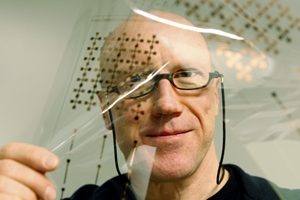Researchers at Tampere University of Technology in Finland are developing a new process for designing and fabricating logic circuits that consume no current and can be read and written with light. The four-year, €1.6 million ($US 2.1 million) study is funded by the Academy of Finland, the country’s main science agency.
The project draws on Tampere’s electronics, chemistry and bioengineering departments, as well as its Optoelectronics Research Centre, and will investigate ways of combining organic chemistry, semiconductor growth, and nanoscale fabrication as the basis for a new technology platform for future nanoscale electronic circuits and devices. The research centers around quantum dots, pieces of semiconductor material that make it possible to measure and manipulate single electronic charges.
Quantum dots can be configured like dominoes, where the position of the charges in one cell affects the position of the charges in the next cell, which then enables the building of logical circuits. This quantum dot cellular automation takes place, however, without electric current flowing among the cells. In addition, the extremely small size of the dots and cells means they could be formed into electronic circuits at densities and speeds not yet possible.
The team led by Tampere electronics professor Donald Lupo (pictured right) aims to use this property of quantum dots to devise circuits that respond to light. The researchers want to attach engineered molecules and optical nanoantennas to the quantum dots. These optical enhancements are expected to inject an electric charge into a quantum dot, or enable the transfer of charges among the dots when exposed to light at the right wave length.
This enhanced quantum dot will then be combined with the circuit design expertise of the university’s Optoelectronics Research Centre, which will build circuits using methods that grow crystal structures on crystalline substrates. The process would make possible a solid-state technology platform compatible with standard electronic circuits, thus allowing light-enabled circuits made with quantum dots to interact with traditional chips and devices.
“It’s highly risky because of many technological challenges,” says Lupo, “but the potential is amazing; being able to get rid of electrical connections and write and read nanoelectronic circuits using only light would be a huge breakthrough.”
Read more:
- Nanotech Process Devised for Graphene Semiconductors
- New Quantum Dot Material Boosts Solar Cell Efficiency
- Nanotech Solar Energy Paint Developed
- Semiconductor Foundation, NSF Fund Nanoelectronics Research
* * *


 RSS - Posts
RSS - Posts
[…] Project to Study Light-Enabled Quantum Dot Circuits […]
[…] Project to Study Light-Enabled Quantum Dot Circuits […]